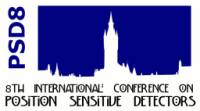Speaker
Dr
Celeste Fleta
(University of Glasgow)
Description
3D detectors are photodiode detectors with n- and p-type electrode columns passing through a silicon substrate. Using this structure, the spacing between electrodes can be made much smaller than the substrate thickness, greatly reducing the collection time and operating voltage of the sensor. The structure should also reduce charge sharing between adjacent pixels, improving the image quality. A variation of the 3D design is the 'double sided' configuration, where neither set of electrodes passes through the full substrate thickness. A set of double-sided 3D detectors with full Medipix2 geometry have been fabricated, bump bonded to readout chips, and connected to the USB interface for Medipix detectors developed by IEAP-CTU (Prague). The sensors have been tested using different radioactive sources and the results have been compared to those of a standard planar detector.
Author
Dr
Celeste Fleta
(University of Glasgow)

